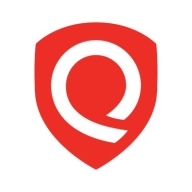

Qualys VMDR and Amazon EKS compete in the field of cloud-based solutions, focusing on vulnerability management and container orchestration respectively. Qualys VMDR appears to have the upper hand in providing comprehensive security features, while Amazon EKS excels in scalability and Kubernetes support.
Features: Qualys VMDR is recognized for its thorough vulnerability management capabilities, real-time updates, and seamless integration with compliance tools. Its asset management and web application scanning modules are highly valued. The solution's ease of deployment as a cloud service is an added advantage. Amazon EKS is praised for its efficient management of containerized applications, scalability, and auto-scaling features. It supports Kubernetes efficiently, making it ideal for multi-cloud environment management.
Room for Improvement: Qualys VMDR users seek better reporting features, fewer false positives, and enhanced asset management capabilities. Improved integrations with third-party tools and a more intuitive user interface are also desired. For Amazon EKS, users highlight the need for improved network plugin stability, simpler managed cluster setup, and enhanced monitoring and logging features. A need for clearer pricing structures and more comprehensive native management features is also noted.
Ease of Deployment and Customer Service: Qualys VMDR provides straightforward deployment across public, private, and hybrid cloud environments, though customer service experiences vary. Amazon EKS, primarily focused on public cloud deployment, sometimes faces challenges with user-defined customizations. Its customer service meets industry standards but could benefit from increased responsiveness and hands-on support.
Pricing and ROI: Qualys VMDR is often seen as expensive but offers significant value for larger enterprises due to its extensive features and asset-based licensing. Amazon EKS provides competitive pricing with a pay-as-you-go model, making it potentially cost-effective for larger enterprises but pricey for startups. Both solutions offer a solid ROI through enhanced security and management capabilities, with Qualys showing clearer direct cost savings from its vulnerability management features.
We have cost explorer available, and a bill forecast based on usage allows us to determine whether resources are underutilized or overutilized.
It's a fast deployment, with very good documentation, and it's really helpful.
I can recommend using it to save costs and for faster deployment, better performance, security, and easy clustering.
We saw a return on investment through significant savings in time, money, and resources.
We have a paid subscription that provides priority support.
Amazon's technical support is quite good, especially for those who purchase support services.
Having to know what questions to ask is essential.
We usually get on calls with tech support, and they are very helpful.
The response time takes a while.
The technical support provided by Qualys is pretty good.
The ability to scale based on requirements by deploying additional containers is a strong point for Kubernetes.
This allows us to scale our applications or APIs as needed, offering reliability through the automation of scaling processes.
It can scale very well according to needs, and it doesn't have any issues with scalability.
Scalability depends on the license and the number of assets being monitored.
Qualys VMDR can handle scalability, although increasing the inventory can raise the licensing costs.
Amazon EKS is very stable, and when properly configured, I rate it ten out of ten.
Amazon EKS is stable.
Simplifying these will enable more people, not just those with strong foundational knowledge, to work effectively with these services.
Amazon EKS can be improved by having the maintenance of Kubernetes versions managed better, as everything is handled by the Kubernetes team and possibly a separate team at AWS.
Adding logging would be a valuable improvement.
It does not automate patching unless the patch management module is purchased separately.
If AI features were integrated, it could enhance the capabilities significantly.
They can tweak their UI since the new version seems a bit jumbled up.
The pricing structure is beneficial for large companies who pay for what they use, but it is not affordable for startups.
Now, it stands at six or seven due to optimizing our workload.
As Amazon is a pay-per-use service, our usage levels are high, so I would desire if Amazon could provide certain discounts or credits for customers who utilize a lot of resources.
I would rate the pricing between seven to eight out of ten.
I have a notion that Qualys might be more expensive than Rapid7.
Qualys offers better pricing and is feature-packed compared to other tools.
The most beneficial aspect of Amazon EKS is that it helps manage the Kubernetes master node, so I don't need to maintain the master node, including tasks like upgrading.
The main benefits that I received from using Amazon EKS are that it is a managed cluster and offers simplicity.
By default, if you just install Amazon EKS, you can deploy your application, but to have it enterprise-ready, you have to configure a number of other things that will boost productivity.
The prioritization of vulnerabilities has improved our remediation efforts by around thirty to thirty-five percent.
It impacts my workflow overall, with the patch management features as it has the missing patches listed in detail, making it easier to get a comprehensive report and providing some dashboards that offer visual representation.
Qualys VMDR offers a one-stop solution for monitoring and reporting.


Amazon Elastic Kubernetes Service (Amazon EKS) is a fully managed Kubernetes service. Customers such as Intel, Snap, Intuit, GoDaddy, and Autodesk trust EKS to run their most sensitive and mission critical applications because of its security, reliability, and scalability.
EKS is the best place to run Kubernetes for several reasons. First, you can choose to run your EKS clusters using AWS Fargate, which is serverless compute for containers. Fargate removes the need to provision and manage servers, lets you specify and pay for resources per application, and improves security through application isolation by design. Second, EKS is deeply integrated with services such as Amazon CloudWatch, Auto Scaling Groups, AWS Identity and Access Management (IAM), and Amazon Virtual Private Cloud (VPC), providing you a seamless experience to monitor, scale, and load-balance your applications. Third, EKS integrates with AWS App Mesh and provides a Kubernetes native experience to consume service mesh features and bring rich observability, traffic controls and security features to applications. Additionally, EKS provides a scalable and highly-available control plane that runs across multiple availability zones to eliminate a single point of failure.
EKS runs upstream Kubernetes and is certified Kubernetes conformant so you can leverage all benefits of open source tooling from the community. You can also easily migrate any standard Kubernetes application to EKS without needing to refactor your code.
Vulnerability Management, Detection, and Response (VMDR) is a cornerstone product of the Qualys TruRisk Platform and a global leader in the enterprise-grade vulnerability management (VM) vendor space. With VMDR, enterprises are empowered with visibility and insight into cyber risk exposure - making it easy to prioritize vulnerabilities, assets, or groups of assets based on business risk. Security teams can take action to mitigate risk, helping the business measure their actual risk exposure over time.
Qualys VMDR offers an all-inclusive risk-based vulnerability management solution to prioritize vulnerabilities and assets based on risk and business criticality. VMDR seamlessly integrates with configuration management databases (CMDB), Qualys Patch Management, Custom Assessment and Remediation (CAR), Qualys TotalCloud and other Qualys and non-Qualys solutions to facilitate vulnerability detection and remediation across the entire enterprise.
With VMDR, users are empowered with actionable risk insights that translate vulnerabilities and exploits into optimized remediation actions based on business impact. Qualys customers can now aggregate and orchestrate data from the Qualys Threat Library, 25+ threat intelligence feeds, and third-party security and IT solutions, empowering organizations to measure, communicate, and eliminate risk across on-premises, hybrid, and cloud environments.
We monitor all Container Security reviews to prevent fraudulent reviews and keep review quality high. We do not post reviews by company employees or direct competitors. We validate each review for authenticity via cross-reference with LinkedIn, and personal follow-up with the reviewer when necessary.